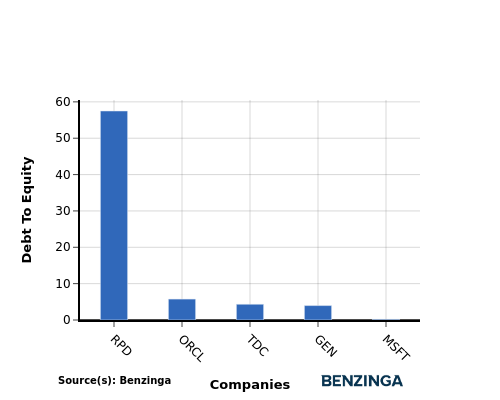Comparative Study: Microsoft And Industry Competitors In Software Industry
In today's rapidly changing and fiercely competitive business landscape, it is vital for investors and industry enthusiasts to carefully evaluate companies. In this article, we will perform a comprehensive industry comparison, evaluating
Microsoft Background
| Company | P/E | P/B | P/S | ROE | EBITDA (in billions) | Gross Profit (in billions) | Revenue Growth |
|---|---|---|---|---|---|---|---|
| 31.47 | 9.59 | 11.15 | 8.17% | 12.27% | |||
| Oracle Corp | 34.22 | 24.44 | 7.47 | 19.27% | 6.4% | ||
| ServiceNow Inc | 121.01 | 17.79 | 15.71 | 4.06% | 21.34% | ||
| Palo Alto Networks Inc | 98.55 | 18.12 | 14.43 | 4.35% | 14.29% | ||
| Fortinet Inc | 44.04 | 51.24 | 12.90 | 43.82% | 17.31% | ||
| Gen Digital Inc | 26.81 | 7.84 | 4.40 | 7.48% | 4.01% | ||
| Monday.Com Ltd | 412.39 | 12.60 | 13.79 | 2.3% | 32.29% | ||
| Dolby Laboratories Inc | 30.23 | 3.14 | 6.04 | 2.72% | 13.13% | ||
| CommVault Systems Inc | 43.49 | 25.26 | 7.92 | 3.9% | 21.13% | ||
| Qualys Inc | 27.98 | 9.95 | 8 | 9.49% | 10.11% | ||
| SolarWinds Corp | 28.84 | 2.26 | 4.04 | 5.26% | 6.14% | ||
| Progress Software Corp | 34.75 | 5.25 | 3.16 | 0.27% | 21.47% | ||
| Teradata Corp | 20.36 | 16.80 | 1.33 | 19.38% | -10.5% | ||
| Rapid7 Inc | 71.78 | 103.70 | 2.15 | -25.97% | 5.36% | ||
| Average | 76.5 | 22.95 | 7.8 | 7.41% | 12.5% |
By closely studying
-
The Price to Earnings ratio of 31.47 is 0.41x lower than the industry average, indicating potential undervaluation for the stock.
-
With a Price to Book ratio of 9.59, significantly falling below the industry average by 0.42x, it suggests undervaluation and the possibility of untapped growth prospects.
-
With a relatively high Price to Sales ratio of 11.15, which is 1.43x the industry average, the stock might be considered overvalued based on sales performance.
-
With a Return on Equity (ROE) of 8.17% that is 0.76% above the industry average, it appears that the company exhibits efficient use of equity to generate profits.
-
The Earnings Before Interest, Taxes, Depreciation, and Amortization (EBITDA) of
$36.79 Billion is 56.6x above the industry average, highlighting stronger profitability and robust cash flow generation. -
Compared to its industry, the company has higher gross profit of
$47.83 Billion , which indicates 35.17x above the industry average, indicating stronger profitability and higher earnings from its core operations. -
With a revenue growth of 12.27%, which is much lower than the industry average of 12.5%, the company is experiencing a notable slowdown in sales expansion.
Debt To Equity Ratio

The debt-to-equity (D/E) ratio gauges the extent to which a company has financed its operations through debt relative to equity.
Considering the debt-to-equity ratio in industry comparisons allows for a concise evaluation of a company's financial health and risk profile, aiding in informed decision-making.
By evaluating
-
In terms of the debt-to-equity ratio,
Microsoft ( MSFT ) has a lower level of debt compared to its top 4 peers, indicating a stronger financial position. -
This implies that the company relies less on debt financing and has a more favorable balance between debt and equity with a lower debt-to-equity ratio of 0.21.
Key Takeaways
For
This article was generated by Benzinga's automated content engine and reviewed by an editor.
Related News
-
Benzinga - 11:01 PM ET 3/31/2025
-
Lightmatter releases new photonics technology for AI chipsÂ
Reuters - 9:02 PM ET 3/31/2025
-
Lightmatter releases new photonics technology for AI chipsÂ
Reuters - 9:00 PM ET 3/31/2025
-
Report: NHL reaches 12-year, $7.7B Canadian TV deal with Rogers
Reuters - 8:53 PM ET 3/31/2025
-
Trump sets up new office to manage CHIPS Act and speed up investments
Reuters - 6:38 PM ET 3/31/2025
-
GlobalFoundries, Taiwanese chipmaker UMC consider merger, sources say
Reuters - 6:12 PM ET 3/31/2025
-
The Analyst Verdict: Unity Software In The Eyes Of 12 Experts
Benzinga - 6:01 PM ET 3/31/2025






